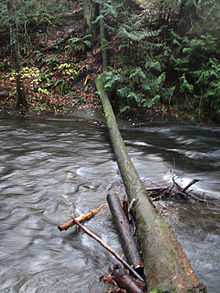Large woody debris
Large woody debris (LWD) are the logs, sticks, branches, and other wood that falls into streams and rivers. This debris can influence the flow and the shape of the stream channel. Large woody debris, grains, and the shape of the bed of the stream are the three main providers of flow resistance, and are thus, a major influence on the shape of the stream channel.[1] Some streams have less large woody debris than they did in the past because of humans.[2]
The study of woody debris is important for its forestry management implications. Plantation thinning can reduce the potential for recruitment of LWD into proximal streams. The presence of large woody debris is important in the formation of pools which serve as salmon habitat in the Pacific Northwest . Entrainment of the large woody debris in a stream can also cause erosion and scouring around and under the LWD. The amount of scouring and erosion is determined by the ratio of the diameter of the piece, to the depth of the stream, and the embedding and orientation of the piece.
Influence on stream flow around bends
Large woody debris slows the flow through a bend in the stream, while accelerating flow in the constricted area downstream of the obstruction.[3]

See also
References
- ↑ Curran, Janet H. "Flow Resistance of Large Woody Debris in Headwater Streams of the Washington Cascades" Abstracts with Programs - Geological Society of America, vol.29, no.6, pp.315, 1997
- ↑ Lawrence, J.E.; V.H. Resh, and M.R. Cover (27 August 2012). "Large-wood Loading from Natural and Engineered Processes at the Watershed Scale". River Research and Applications 29: 1030–1041. doi:10.1002/rra.2589. Retrieved 10 November 2013.
- ↑ Daniels, Melinda D; Rhoads, Bruce L "Influence of experimental removal of large woody debris on spatial patterns of three-dimensional flow in a meander bend" Earth Surface Processes and Landforms, vol.32, no.3, pp.460-474, Mar 2007
